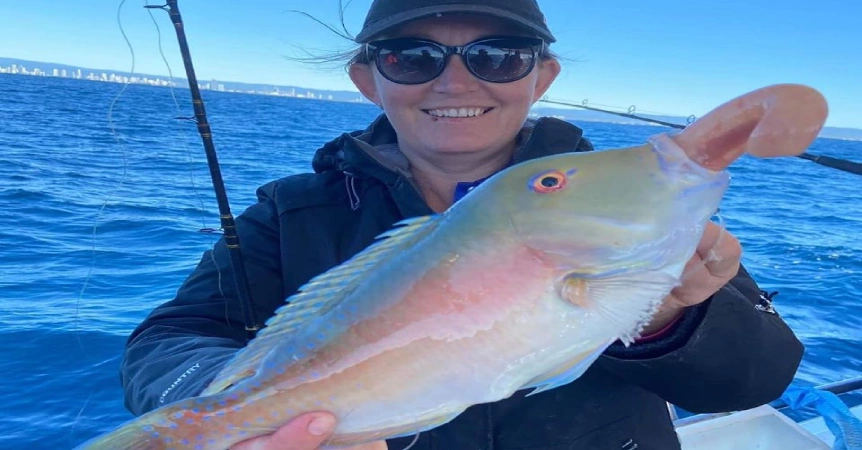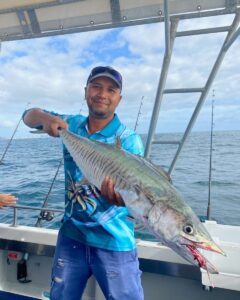
Mixed reef fish Gold coast
We have some great mixed reef fishing species in our local offshore waters. We seem to get a good blend of reef species off our coast. From southern species to northern species, our grounds are where their borders over lap. The most common mixed reef species are Snapper/ squire, Spangled emperor, Pearl perch, Maori cod, Venus tusk fish, Pig fish, One spot sea perch, Gold spot Wrasse, Parrot fish, Teraglin, coronation trout, red throat, job fish, Blue grouper, Hussar, Mangrove jack, Red scorpion fish. Plus a variety of different cod species, emperor, black spot snapper, flame snapper, mosses snapper( finger mark), Gold band snapper, ruby snapper, sweat lip, Trevally, wrasse, trigger fish and leather jackets all frequently visit and or live on our reefs off our coast.
Size and bag limits for key reef species are:
- Snapper/ squire = 35cm and 1 over 70cm and a bag of limit of 4 in total for QLD. 30cm and a bag limit of 10 for NSW.
- Spangled emperor = 45cm and a bag of 5 for QLD. N/A size limit and a bag limit of 20 for NSW
- Pearl peach = 35cm and a bag of 5 for QLD. 30cm and a bag of 5 for NSW.
- Tuskfish = 30cm and a bag of 6 for Qld. N/A and bag of 20 in NSW.
- Maori cod = 45cm and a bag of 5 for Qld. N/A and a bag of 20 for NSW.
- Pigfish = 25cm and a bag of 5 for Qld. N/A and a bag of 20 for NSW.
A maximum possession limit of 20 per day including frozen or fish that are stored at home or camp for QLD and NSW and must meet the species length and bag limits.
cod fishing gold coast reefs
Best Time for Gold Coast Reef Fishing
The best time to catch mixed reef fish is just after the full moon. As most reef species fish like to spawn on the full and new moons and will feed up hard just after the these moons to replace their fat reserves which they live off while spawning. First light on close reefs always fishes best. Then dropping off to deeper reefs as the sun rises is a must as most reef species will migrate with the sun and with the night fall. So with night fall they will move in close on shallower reefs and as the sun rises they will drop off onto deeper reefs in search of darker water. But you will still catch most species all day or night on close reefs. If you can coincide a tide change or key bite times with dusk or dawn even better.
Where to Find Reef Fish Off the Gold Coast
Best places to find mixed reef fish species is on close reefs just offshore like 18, 24, and 36 fathom reefs which are not too far offshore. Most are commonly caught from 20metre to 50metre mark. Most mixed reefies like to sit in packs on top of the reefs feeding up on coral, crabs, baby cephalopods ( squid, octopus), baby fish, bait fish, crabs and crustaceans. So look for fish hugging the bottom or just off bottom on your sounder. The more they are up in the water column the hungrier they seem to be. Burley will help get them up feeding off the bottom.
Best Reef Fish Baits
Drift baiting is still one of the best ways to score mixed reefs on close reefs with not much current. A small running pea sinker to either a double snelled rig or a single 3/0-6/0 hook. Penetrators, suicide, circle and live bait hooks all work well. But you will fish with an open bail arm most of the time as you are always adjusting your line length so it stays close to bottom. You can use pillies, squid, strip baits, Butterflied baits, live baits, dead baits and any combo baits.
Reef Fish Rigs
A Paternoster rig are great for when the current is up or deep bottom bashing. A snapper lead 2once to 24once (depending on current and depth) with one to two droppers off it again teamed up with 3/0-6/0 hooks is still a very affective way to catch mixed reefies. *try mixing it up with a half pillie on one hook and a bit of squid on the other. Combo baits always work great.
Gang or snelled rigs are great, running a ball sinker to a set of gangs and slowly drift it a few feet off bottom is also a very affective technique. Running a cock in a soak (combo baits) on this rig will see the bigger fish hit your baits.
Live bait rigs will catch the biggest reefies on live baits. Small pea sinker to a 4/0-8/0 hook.
Artificial’s
*Plastics:
Still one of the best ways to catch mixed reefies on artificial’s. Depending on depth and current will dictate what size jig head you use. But 1/4- 2once coupled with a 3-9 inch plastic and will work well out to the 36 fathoms. Most profiles work well. Jerk shads, paddle tails and grubs all work well. But bright colours before and around sun up and natural colour once the sun is established. You will have to go to a bigger jig head for deeper water.
*Micro jigs:
The best jigs that always catch fish are slow pitch, flat blat and flutter jigs. 15- 300g jigs will work out to the 200m mark. Again work the right jig in the right depth. So light jigs up to 100g in close and jigs up to 300g or more for out wider then 100m. But you want to hit bottom with your jig. And start jigging. So lift, drop. lift, lift, lift, drop. Then a once your jig is too far out the back of the boat crank it back in and drop it again. You will often get a tuna, kingy or cobia Chase it when cracking it back in. Colours depend on the day and how much UV there is. But most colours work well.
*Octa jigs:
Very similar to micro’s. You can work them with your rod or just stick them in the rod holder. ( in the rod holder) the swell give the jigs a natural movement. But 10g – 100g jigs all work. Lacarnos are probably the best. But watch out for the leather jackets they will eat you tassels, feelers and legs off you jigs.
*flasher rigs:
You can buy pre made flasher rigs which are hooks with tassels and glow beads off them. This coupled up with bait can really fish well. So you want to run it like your paternoster rig with a sinker on the bottom. Sinker size will depend on depth, wind and current.
*trolling hards:
You can actually catch good mixed reefies on trolled hard bodied lures. You want to run you lures about 1m off of bottom. So a down rigger can help you do this. Or just choose the right hard body for the depth. Just so it hangs above bottom. Any 90mm – 200mm hard will work out there. Maybe start off with cheap ones when first start out. As you will loose a few to the reef till you work out your depth.
*Drifting or anchoring:
Both ways catch fish. If drifting a sea anchor will slow your drift down and help stabilise your boat. Drifting allows you to cover more ground and find more fish.
If Anchoring you will want to burley hard. Cubing will also help. But remember. Your burley must be very fine like snow and your cubes really small. Only throw one or two out every 2mins. You want to get them hungry not feed them. Using burley while anchoring will drag any reefies that are down current of you up to you and is a very affective tool in fish the reefs. We even burley while we drift and this is call seeding the grounds. So you just keep working that drift line and over the same ground and the fish will all come up off bottom and start feeding on those grounds your drifting.
There is a lot of different species of reefies that visit our reefs. So having a fish ID app, fish ID books like Grants guide to fish or a fish almanac will help you identify the species you have caught. Which mean there will be no confusion when you get back in or with fisheries.


